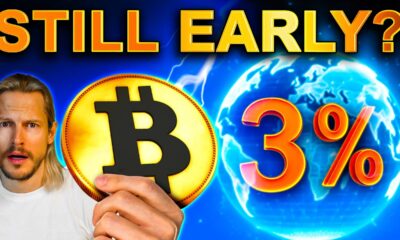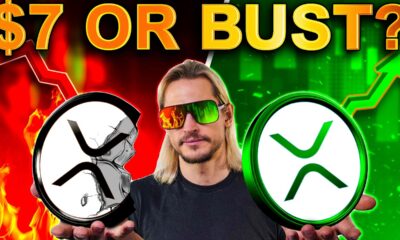Tech
Tech That Change Will Crypto’s Future: Jason Lau

Episode 115 of the Public Key podcast is here and in this episode we speak with Jason Lau (Chief Innovation Officer, OKX) who was fresh off of a global tour, where he attended conferences in New York, Paris, Dubai, and Brazil and provided a regulatory summary of his travels. Jason also shows us technology that could shape the future of crypto including inscriptions, new layer 2 blockchains and interoperable crypto wallets.
You can listen or subscribe now on Spotify, Apple, or Audible. Keep reading for a full preview of episode 115.
Public Key Episode 115: The Future of Exchanges: Balancing Centralization and Decentralization
When we started this podcast just over 2 years ago, Bitcoin ordinals and inscriptions weren’t even born yet and centralized crypto exchanges releasing their own wallets sounded like fanciful thinking at best.
But here we are as these new and evolving technologies are leading the evolution of Bitcoin and the cryptocurrency industry at large. In this episode, Ian Andrews (CMO, Chainalysis) sits down with Jason Lau (Chief Innovation Officer, OKX) who shares his insights and observations from his recent global tour, where he attended conferences in New York, Paris, Dubai, and Brazil.
Jason highlights the growing momentum and enthusiasm in the crypto and Web3 space, as well as the importance of localizing products and services to cater to diverse user bases.
Jason also discusses OK Group’s focus on self-custody and the launch of their OKX wallet, which aims to empower users to explore the world of decentralized finance (DeFi).
Additionally, he touches on OK Group’s Layer 2 network (X Layer), their foray into inscriptions (NFTs on Bitcoin) with a new marketplace and their efforts to cater to institutional clients.
Quote of the episode
“We want people to use their crypto. They can certainly use the exchange to gain access, hopefully learn and buy the first or make some trades there. But ultimately, there’s a whole world that we envision will come about and we collectively call this Web3.” – Jason Lau (Chief Innovation Officer, OKX)
Minute-by-minute episode breakdown
2 | Global crypto enthusiasm and regulatory conversations from NYC, Dubai and Brazil
4 | OK Groups International expansion and broad customer base
7 | Advancing transparency and self-custody in crypto exchanges and understanding the evolution of the proof of reserve audits
11 | Embracing Web3 through user-friendly crypto wallets and building a L2 blockchain (X Layer)
16 | The evolving role of crypto exchanges and the impact of DeFi Regulation
22 | Exploring the impact of inscriptions on the Bitcoin network and whether NFTs are Dead
25 | Innovating institutional crypto trading and custody solutions
28 | OKX’s upcoming Web3 initiatives with McLaren F1 and Manchester City FC
Related resources
Check out more resources provided by Chainalysis that perfectly complement this episode of the Public Key.
Speakers on today’s episode
- Ian Andrews * Host * (Chief Marketing Officer, Chainalysis)
- Jason Lau (Chief Innovation Officer, OKX)
This website may contain links to third-party sites that are not under the control of Chainalysis, Inc. or its affiliates (collectively “Chainalysis”). Access to such information does not imply association with, endorsement of, approval of, or recommendation by Chainalysis of the site or its operators, and Chainalysis is not responsible for the products, services, or other content hosted therein.
Our podcasts are for informational purposes only, and are not intended to provide legal, tax, financial, or investment advice. Listeners should consult their own advisors before making these types of decisions. Chainalysis has no responsibility or liability for any decision made or any other acts or omissions in connection with your use of this material.
Chainalysis does not guarantee or warrant the accuracy, completeness, timeliness, suitability or validity of the information in any particular podcast and will not be responsible for any claim attributable to errors, omissions, or other inaccuracies of any part of such material.
Unless stated otherwise, reference to any specific product or entity does not constitute an endorsement or recommendation by Chainalysis. The views expressed by guests are their own and their appearance on the program does not imply an endorsement of them or any entity they represent. Views and opinions expressed by Chainalysis employees are those of the employees and do not necessarily reflect the views of the company.
Transcript
Ian:
Hey, everyone. Welcome to another episode of Public Key. This is your host, Ian Andrews. Today, I’m joined by Jason Lau. He is Chief Innovation Officer for OK Group. Jason, welcome to the show.
Jason:
Thanks for having me.
Ian:
Now, you’ve been on a whirlwind tour. You and I saw each other a few weeks ago as we’re taping this at the Lynx Conference in New York. You went from there basically around the world. What have you picked up as you visited Paris and Dubai? We’re now talking, I think you’re down in Brazil, having just come off of Web Summit, what’s the state of the world of crypto and technology as you’ve taken in this global perspective over the last few weeks?
Jason:
Yeah, you’re right. It’s been a little bit of a whirlwind. By overall takeaway broadly is that, there’s a lot of momentum and there’s a lot of enthusiasm across the world. As we said around what’s happening in crypto and Web3. We were in New York, it was actually less than two weeks ago, right?
Ian:
Yeah.
Jason:
We were in New York and you guys put together a great conference bringing the public sector as well as the private sector together, and there’s great interaction there, learning about what law enforcement and others are doing. Then, you would go over to Paris and you see some of that conversation carry over, but more skewed towards the regulatory side.
I think there was a lot of chatter around, especially with Europe getting closer to having Mika come into force later this year. There’s a lot of chatter there. But also you saw a lot of industry folk, especially around Europe, but globally show up there too. It was a really good, well-turned-out event.
Dubai was interesting too. I went to a conference called Blockchain Life, and that was unique to me because there’s a really strong representation from the mining community there. And so, I would wager it was something like 30% to 40% attended by miners and that group.
And so, learning about what’s going on their thoughts about the halving that’s coming up later today as we record. Fascinating, fascinating also in the hardware improvements that are coming out on the mining side. And then, finally, here in Brazil, I was in Rio just yesterday, the past few days, Web Summit’s a broader than Web3 Conference, right? It’s more tech and it’s more general. But there was a Web3 specific track and it was really cool to see all the energy and vibrancy for people that were keen to learn more.
Ian:
Yeah, it is refreshing after I think 2022 sort of a down… Emotionally down year as well as maybe from an asset price perspective where I think people maybe weren’t sure where the world of crypto was going. But this is why I’m so excited to have this conversation with you, given your role driving innovation for one of the biggest exchanges in the world. I feel like we’ve got a window into the future a little bit here.
Jason:
Maybe.
Ian:
So, I’m excited to dive into all the cool stuff that OK Group is working on. But I’m curious before we get to that like, how does one become the Chief Innovation Officer? Because that seems like a cool title. I’m a little bit aspirational. Maybe one day I could take something like that on. Maybe, walk us through your story that led you to this place in your career.
Jason:
Yeah. I mean, Ian, I think I’m very fortunate also, my journey starts in TradFi was basically my initial career. I left that in about 11 years ago. I was at Barclays before out in Hong Kong, and I tried to get into tech. Me and a couple of co-founders went to the Bay Area and tried to do our own startup. This was in the crowdfunding space. I don’t know if you remember that was pretty popular back then…
Ian:
Yeah, sure. Yup.
Jason:
It didn’t work out, but was fortunate to learn about Bitcoin and all the possibilities that people were dreaming up of back then, and that unique intersection between Bitcoin and economics and game theory and all this. I think that was super fascinating.
Fast forward just a little bit, it wasn’t until 2016 before I joined OK Group. And I’ve done a whole bunch of stuff here, including BD, including institutional, including… I moved over to the US in 2018 to set up our US business, so it’s been a lot of changes. You’ve also identified crypto is volatile, right? I think for me at least, it’s being able to see through all those cycles and have gone through them and take the good and the bad, and just have that perseverance to get through it.
Ian:
Yeah. Now, setting up an exchange in the US is not for the faint of heart, the complex regulatory landscape. I’m curious today, I think most people know okay, group as being the maybe second biggest exchange by volume, but catching up pretty quickly to the folks in first place. How does that business break out around the world? Where are most of your customers and most of the revenue coming from? If you can share.
Jason:
We were founded 10 years ago, sorry, 11 years ago, 2013 in China.
Ian:
Yeah.
Jason:
And so, as a result, a lot of our users… And we’ve grown globally, and we’re now really a global company. We have over 300 people in the US alone.
Ian:
Wow.
Jason:
And so, we still have those roots where our early days were very Asian-focused, so we have a lot of Asian folk users. That said though, our journey has really pivoted to become a global company, trying to serve global users.
Ian:
Yeah.
Jason:
We’re working really hard to continue that and really deepen our roots in a wide variety of low vote jurisdictions. We just got our license in principal license in Singapore early this year…
Ian:
Congratulations.
Jason:
… in Dubai with VARA, the regulators there. And here sitting in Brazil, we launched our Brazil market and product here a few months ago, so we have a local team here in Brazil with 20 plus people and offering really customized local Portuguese products and customer support and all that.
So, I think our user base is really becoming very diverse. And I think that’s very powerful because it ties into what crypto really is all about digital first obviously, but it’s really a global community.
Ian:
Yeah. How much do the products that you offer across all those different markets vary? I mean, I know there’s different restrictions on token listing standards. There’s some markets like the US that are very restrictive on futures and derivatives trading versus say, spot trading. If I were to come down to Brazil and get access to your Brazilian platform, would that look completely different from what I would see in the US versus what I might see in Dubai?
Jason:
I wouldn’t say completely different. I mean, I think we feel that we’ve brought a really nice seamless user-friendly experience from the visual aspect, but you’re absolutely right. The products and services themselves vary quite differently. And again, that ties down to understanding the what’s permissible, what’s suitable for local jurisdictions.
And so, in different jurisdictions, you will obviously see the language difference. I think that’s a key. Being able to offer customer support in different languages and the educational tools in different languages tailored to what’s interesting to different areas. I think that’s also very powerful and that’s an area where we’re working hard on.
And then, even if you look at places like the UK, which is very specific requirements around what you can and cannot say in terms of marketing. We work very hard to understand that. We talk to all of our public sector stakeholders, regulators, policymakers to understand what they’re thinking. And we try to implement that, right? We’re hopefully very constructive and collaborative with all of these various stakeholders around the world. And ultimately, that’s because these products need to be localized and they need to be suitable.
Ian:
Yeah. How do you think about, obviously, OKX centralized exchange, but you operate in this world of DeFi where self-custody holds an important place in a lot of people’s hearts, philosophically, I think. How does that influence some of the products you’re thinking about building and your strategy and market?
Jason:
Yeah. So, self-custody to us is a core, core function of what crypto enables, and we want users to discover. We want users to learn about that. We want users to withdraw their crypto, frankly, and go and explore, do something with their crypto, whether that’s self-custody at its most basic level. But then, user wallet, user Web3 services, go and just check things out. I think there’s increasingly a wider amount of applications that are on chain now, so that’s very cool.
And so, for us, when we build our centralized products, we try to infuse it with that crypto ethos of transparency and accountability, excuse me. And I think there’s a couple of examples where I can highlight. One is our Proof of Reserves Program, I think that’s a program where users can basically verify that the exchange has not misused or mishandled their digital asset funds.
They can do that by checking their balances with the assets that are on chain. We’ve revealed… I think the latest number is over 450,000 different public blockchain addresses where they can check that those funds, that digital assets are still there and they haven’t been misused. And I think that’s very powerful. We’ve been doing this for 17 months now. And it’s great to see that the industry continue to embrace that.
Ian:
Question about that, 450,000 addresses sounds like a lot, but that’s quite a bit less than the number of customers that you have. So, you still have omnibus wallet infrastructure…
Jason:
Oh, absolutely.
Ian:
… where you’re consolidating deposits in the infrastructure that has varying levels of security and things like that, it sounds, yeah.
Jason:
Yeah, so just to be more specific, what in the proof of reserves, what it does is it takes all the liabilities of the exchanges. The users can take their specific balances and ensure that without getting to the technical part, ensure that it’s included in that liability piece.
Ian:
Oh, amazing.
Jason:
But also, that the exchange has not included negative balances to manipulate or do something fraudulent there. So, there’s a zero-knowledge proof that basically ensures that. So, once you’ve done that, that hey, look, the exchange users in totality has X amount of liabilities. And my number is included there.
Then, you go and compare it to the omnibus addresses of the crypto assets that we support on chain. And you take a look like, “Hey, OKX users have whatever, it’s 500,000 Bitcoin, I have five of those. How many does OKX show on their Bitcoin addresses? Their omnibus Bitcoin addresses. In their cold wallet, whatever it is. And so, that’s at its core basically what proof of reserves is. But obviously, there’s a bit more systematic tooling and ways that we do it so users can actually access that a little bit better.
Ian:
Well, I mean, that’s super helpful for a user to be able to actually get that cryptographic proof that the assets they believe they’ve deposited are included in that proof. And so, you’re not double counting where your five Bitcoin and my five Bitcoin…
Jason:
Exactly. Exactly.
Ian:
We think they’re there, but we can’t tell, right?
Jason:
Yeah.
Ian:
I mean, that was when proof of reserves first became a thing in the wake of the FTX collapse, there were a lot of gaps where people were poking holes in, and not being transparent enough to actually be meaningful. But it sounds like you’ve addressed that, which is amazing.
Jason:
Yeah, I mean, this program has been upgraded over time. I rightfully agree with you that there were earlier gaps to the earlier Merkle tree approaches and different approaches or using third-party auditors and things like that. I think what we’re trying to do is look to improve that too. We’re working… We don’t have anything to announce specifically, but we’re working to see how we can even get the process that we do, the proof of reserves audited and under a SOC 1 or SOC 2 or something where we can get that audited. And again, provide more accountability to what we say we are doing.
Ian:
Yeah, that’s outstanding. Shifting gears a little bit, one of the things you talked quite a bit about in your links presentation was the OKX wallet experience, and it sounds like you all have put a tremendous amount of effort into this, which on the surface from a strategy standpoint maybe is a little counterintuitive because you’re kind of encouraging users to take their assets off the exchange and go out, and interact with DeFi protocols, move them to other chains. Talk a little bit about why you’ve invested so much in that, and maybe some of the highlights of what you’ve been building there.
Jason:
Yeah, Ian, we’ve been building this product for over two years now. And even internally, we have over 400 people working on this side of our business. It’s a bit new to us, and it’s very important to us actually precisely because of some of the things I talked about earlier, which is we want people to use their crypto. They can certainly use the exchange to gain access, hopefully learn and buy the first or make some trades there.
But ultimately, there’s a whole world that we envision will come about and we collectively call this Web3. And so, owning your crypto is the first step. The idea that you have sovereignty over your assets, and hopefully over your data and all that, I think is a bit of a shift for users, especially in this Web2 world to understand, and we absolutely want people to go and experiment and try it out.
So, in the wallet at Lynx, I talked about how we’ve built it in a way that’s very accessible to existing exchange users. It’s actually just a toggle within the app itself. So, you switch over to this Web3 mode, and then you set up your wallet whichever way you want to set it up. And then, you can go and explore and do all these things. We focus on making sure the experience is very seamless. The exchange obviously supports a lot of assets, a lot of different blockchains and networks, likewise on the wallet.
So, we have 90 different blockchains and networks that are supporting the wallet. I think that’s the most out there on the market today. And again, it’s because you want users to think that if I am interested in some use case, some game, something on some NF NFT collection on chain, I don’t have to go and figure out which wallet that is or which wallet supports which chain or which it’s complicated.
Ian:
Yeah.
Jason:
And I think the simple analogy I like to use is either it’s like a browser or it’s like an operating system for someone to just start doing things that you using those applications, but you don’t want to download a different browser just because the website is hosted on a different cloud server or something, right? It doesn’t seem right. And so, that interoperability was the focus of our wallet, but also the focus of my talk at Lynx.
Ian:
Yeah, I think we’ve both been in tech long enough to remember the battle days when websites only supported Internet Explorer, and you would get that banner at the top if you were trying to use anything else. It said, “Please download IE before you can proceed.” For a lot of people, that’s the state of Web3 right now is like this difficulty of interoperability.
Speaking of interop, you’ve also recently launched a Layer 2s network of your own. Talk about the strategy behind that because I’m watching the proliferation of Layer 2s on Ethereum, and there’s quite a few now, and I don’t totally understand the end game there, so I’d love to understand if you’re willing to share the thought process that led to you all launching your own Layer 2 and what you expected to develop across that new ecosystem.
Jason:
For Layer 2s, there’s a lot of debate about the end game. I rightfully agree. And I think primary, Layer 2s are a scalability solution, right?
Ian:
Sure.
Jason:
And so, we’ve gone through and seen what happens when Layer 1 networks get congested, basically unusable. And that you can’t build functioning use cases on the back of that. It’s just not, this is to use, again, the old tech analogies, right? It’s like trying to build Zoom on doubt, right? It just doesn’t work, right?
Ian:
Yeah.
Jason:
It just doesn’t work. And so, you need that scalability and that translates to cheaper fees and fast transactions and all the benefits there. But ultimately, it opens up more the ability for developers to come up with these new use cases. And so, when we come to our Layer 2, what we’re thinking is, yes, there’s those technology benefits.
We’re hoping to attract developers that want to connect with our ecosystem, right? Because we have all these pieces in play. We have the exchange. We have the liquidity. We have the wallet as well as the community. We have the distribution and the community and the users. If there are developers that want to experiment and build on X layer, that’s the name of our Layer 2, we highly encourage them to do so. But that doesn’t mean that we are only going to be supporting X layer.
Again, back to the earlier topic of interoperability, we support base like Coinbase is Layer 2. We support a wide variety of networks, and we highly encourage them to go and play around there. But I think with the pieces that we have in our stack, I think it’s a unique opportunity for developers to come and experiment over here. So, we’ll see. We’ll see where it goes. But I do think that it’s a great opportunity.
Ian:
On X Layer, have you gone so far as to build your own DeFi protocols? Have you introduced a lending or a DEX style exchange on the Layer 2 network?
Jason:
We have seen a few projects deploy on X Layer already, and those are certainly in the lending and DEX categories. It’s only been officially live for three days, so I need to go back and check and see what those metrics look like. But the early response has been phenomenal. I’ve heard from the team that there are over 200 different projects and protocols that are talking to us in the midst of the deploying, so we’ll see.
Ian:
Amazing. Amazing. It would seem to me as an outsider that given the advantages that you have in terms of liquidity and kind of capital available, that you could seed a very large DEX style operation that would probably draw in lots of trading activity, simply because of the capital that gets deployed. But it sounded like from your last answer that that’s not in the works, that you’re not planning to necessarily build your own on-chain operations.
Jason:
It’s possible. I mean, I wouldn’t rule that out. I’m just saying that right now, we’re encouraging developers around to come in and build here. I think our role is really to provide that playing ground, that surface for people to build stuff on. And meanwhile, we have all these other pieces that I talked about, the users most importantly, and that seamless experience that they can go and access X Layer very, very quickly through the exchange and the wallet as well as the liquidity connection between the exchange and the X Layer.
So, I think those are the building blocks that we put into place. At this point, we haven’t announced or that we’re building anything with those building blocks per se, but we do want to see the community see what they do with that.
Ian:
Yeah, I listened to an interview with Brian Armstrong a few months back about the very early days of Coinbase, and how his initial product was actually a wallet for the Bitcoin network. And after some time in market, he realized that the struggle for getting people to use it was they didn’t know how to get anything into the wallet. It was the on-ramp from the traditional fiat currency that was really the barrier to entry. And that led him down the path of needing to create an exchange.
And then, obviously, fast forward now 10, 12 years on, we see most trading activity is, or I guess probably about half of trading activity now runs through exchanges and they’ve become much more full featured. Do you see a world where years into the future exchanges almost revert back to that early notion of being primarily fiat to crypto bridges, the on-ramp, off-ramp experience? And most user activity is happening through smart contracts, decentralized protocols happening on chain? Or do you think there’s a bigger role to play for exchanges?
Jason:
I think exchanges are now and going forward for quite some time. I think they will be very important part of the onboarding process for users. I think we are still far from a world where people even understand what on-chain DeFi, what is a digital wallet. I mean, I don’t think people are really… I mean, that very broadly in the broad sense, where there’s still a lot of work to do in educating the general population about why digital assets are actually scarce, and why you might want to safeguard that. That’s the concept that we haven’t grown up in. That’s not a world where we’re familiar with. And almost always today you rely on someone else to help you do that, anything digital.
And so, I think exchanges play that role, whether it’s actual on-ramping with fiat, but the educational on-ramp, the access and all that. I think that’s still a critical role for exchanges, and it’s natural for exchanges to build a stack on top of that, stack of features on top of that. Again, in the US in particular, we’ll see where the regulations go, but we’re already around the world. We’re seeing regulators be comfortable with that, right? That’s what they’re making sure there’s enough consumer protection in place, and the good players get licenses, and hopefully build that out.
So, I think we’re going to see this world of… What do we call it? Just centralized exchange, decentralized products and services. I think we’re going to commingle there for quite some time.
Ian:
Yeah. Well, and just as we’re recording this, in the last week, the SEC and the US served Uniswap with a Wells notice, which TBD, how that gets, that plays out over time. These legal disputes can be pretty protracted. But you could imagine a scenario where DeFi ends up having to adopt a lot of the compliance and AML, and kind of operational best practices that we see from exchanges rather than being treated as autonomous code running on-chain because there is a business around it in that case. So, I think there’s a… And maybe the DeFi comes closer to the exchange world over time too. It goes the other direction potentially.
Jason:
I’m no lawyer and I’m keen to see the outcome of that too.
Ian:
Yeah.
Jason:
I was in Brussels last month talking… Sorry, I was at a DeFi regulatory discussion round table. And a lot of bright minds in the group… And we spent a third of the time just trying to define what DeFi was. I think we’re trying to get to the grasp of what this stuff is, and some of it will play out in the courts. Some of it will play out with policymakers. My hope is that we get something really thoughtful. I think there is something pretty powerful here when we enable able broadly these products and services. And I hope we end up with something in a good place.
Ian:
I agree. I agree with that sentiment entirely. Shifting gears again, can we talk about inscriptions?
Jason:
Sure.
Ian:
You all recently launched an inscriptions marketplace, and I’m still scratching my head a little bit about what inscriptions are? What the appeal is? And maybe, just talk about what you all have seen since launching the marketplace and where you see that feature of the Bitcoin network going?
Jason:
How familiar are you with them?
Ian:
Well, it sounds like it’s kind of like NFTs on Bitcoin is the way that it’s been talked about most broadly, but in some limited ways. And I know there’s some debates raging about, “Hey, is this just clutter on the network that’s going to drive up transaction fees and reduce storage for all of us? And do we even want this to exist?” So, that’s about my level of depth right now.
Jason:
I think that’s pretty comprehensive. I think you’re pretty caught up, frankly. But inscriptions really, I mean, it started with Ordinals, right? Which was the first protocol that just built on top of Bitcoin and enabling things like NFTs on Bitcoins and tokens that it can be minted on Bitcoin.
So, really, it’s using the Bitcoin block space to enable these other things. And we are big supporters of Bitcoin the ecosystem and getting more users of Bitcoin. I think, broadly, historically, we’ve been pretty early to Bitcoin innovations and upgrades and things like that. I mean, we can look back at SegWit and Taproot and Lightning and all these things.
We’ve been generally fairly on the earlier side, for sure. And when we saw Ordinals, it made sense that there’s a way to enable additional functionality on Bitcoin, but not compromise on what Bitcoin at its core does. There’s no change to the protocol. If you wanted to send a transaction, you still can, right? The crowding out debate, I think it’s more like, “Is my use case better than your use case?” I think that’s a debate we can have forever. And I don’t think that’s particularly constructive, but what is important is that people are using Bitcoin. And there’s demand for Bitcoin block space. There’s an increase in fees. This is good for miners. It’s good for the ecosystem. There’s attracting more developers, more capital, whole bunch of stuff.
And so, I think broadly that’s why we were so excited. And now, we’ve launched this inscriptions marketplace really as a one-stop shop for someone. Again, I go back to how do we make this stuff accessible for users who’ve learned, and then now want to try and check out some of these NFTs on Bitcoin? We’ve made that really accessible within the app. It’s a pretty powerful tool. I would recommend you check it out. It’s like an NFT marketplace that you can see all these inscriptions on Bitcoin as well as actually on I think one or two other networks too.
And inscriptions, just for how I would explain to layman is just look, they are more permanent versions of the NFTs that you might’ve learnt about a couple of years ago. These are actually objects and data that are stored on chain, and they’re truly immutable, but you pay more for it. There’s a cost to that. You’re consuming something. And so, is that worth it to you? I don’t know. That depends on your own taste.
Ian:
What’s your sense of the overall NFT market? I saw a headline earlier in the week that the floor price of the Bored Apes is at the lowest point that it’s been in a year and a half, two years. And I didn’t go deep enough to see if that is a broad trend or if that is isolated to something maybe going on within that community and collection. What are you seeing as you look broadly across NFT market? Is it coming back like we’ve seen with asset prices? Or is it still in the winter phase?
Jason:
I think NFTs are lagging the market a little bit in terms of recovery, especially in price, especially for some of the older collections, Bored Ape is a good example. But I do think that there is this bounce back in interest. I just don’t think it’s played out where the collection that you and I might be familiar at. We talked about Ordinals just now. There was a large surge of interest in NFTs on Bitcoin just second half of last year.
And I remember seeing that the top three traded collections, NFT collections across crypto. The top three were all on Bitcoin, and this was fairly recently. So, maybe the attention has shifted a little bit. Maybe people have realized that, “Wait, if I’m spending $10,000, $100,000 on an NFT, I actually do want it to be inscribed.” I mean, that seems like it might be more valuable, and maybe you’re seeing a shift in how people are consuming NFTs.
So, I mean, we’ll keep an eye. I think it’s not going… NFTs are not going away. I think it’s an interesting media. I think we just need to see where that intersects with users and what they want.
Ian:
Fascinating. We’ve talked a lot about I think the retail and almost by implication the novice user experience. But obviously, OKX is serving professional traders and I would assume has a meaningful institutional business as well. What’s new and exciting in that world? What are you doing to drive innovation there?
Jason:
On the institutional side, I think the big narrative obviously was this Bitcoin ETF and all the… I think really helped people get off their chairs, I guess. Let’s get going and let’s finally do something. We’ve been talking to institutions for a long time now, and a lot of them have been on the sidelines for a long time and it’s good to see finally, action. I think people get it, and that’s an implicit approval, I guess, or stamp that this is actually real, at least from a financial institutional side, I think that was a big, big driver.
One thing that we have done specifically working with some of our top institutional clients was this transition to how do we improve and minimize their counterparty risk with exchanges? And one of the ways we’ve been doing it is working with third-party custodians to enable off-exchange custody of assets. It’s as simple as institutions would store their assets on a third-party custodian.
We have a tripartite agreement, and those assets are available for trading on the exchange, so they get to split out some of these risks that they have. There’s obviously some efficiency costs there, but they’re willing to put up with that like the biggest one that we’ve announced is with CoinShares and Komainu. This was announced about six months ago, and that’s going really well. I think we’re seeing a lot of people take that model and replicate that across the industry.
Ian:
Yeah, I mean, that’s certainly what we see in the equities market. And I know in certain countries around the world, even in digital assets, it’s required by law. I think Malaysia has a requirement that you have to use a third-party custodian. The exchange can’t hold the assets, so that’s fantastic. You’ve been able to enable that.
Jason:
Yeah, I mean, for us, we actually have a… I don’t know if it’s like a marketing phrase, you’re the marketing guy, I don’t know. But we do take this approach of being open with… At one point someone said, “Hey, you can bring your own custodian and we’ll connect to it and we’ll make sure it works, I think so. We’ve generally taken a very open approach listening to the users, what the institutional users, what they want, which custodians we should support and all that.
So, we’re happy to do that. One thing that I do want to add is, there are obviously efficiency trade-offs here, right? There are cost trade-offs. You’re adding another business in the equation. And so, that’s up to the clients. I think it’s up to them to assess what works best for them, and we want to have more choice and that’s good. I think that’s the… We’ll see where it goes.
Ian:
Yeah, BYOC, bring your own custodians.
Jason:
Yeah, that’s exactly what we were partially talking to clients with that tagline.
Ian:
Well, Jason, this has been a fantastic discussion. I’ve really learned a lot. What should our listeners be looking out for from OKX over the next year? What’s exciting and on tap? Let’s break some news here.
Jason:
I wish I came prepared with a list of announcements. But Ian, I can share with you maybe a couple of things that are exciting. I think that this is more for… We talked about getting a wider audience into crypto, that awareness and learning and all that. We partner with on the brand side with McLaren and with Manchester City.
Ian:
Yeah.
Jason:
We’re very fortunate that they are so eager to have their fan base, their community learn and dive into Web3 also, so stay tuned. It’s imminent that we will be announcing some stuff that we’re doing with them really to bring more users into Web3, so stay tuned for that. It’s more of a teaser, sorry. But I’m very excited about it. I took a peek at some of the work that’s being done there. I think it’s going to be fantastic.
Ian:
Well, that’s great. I’m a big F1 fan, and I think the McLaren team…
Jason:
Which team?
Ian:
I’ve been a Lewis Hamilton fan. He was who first got me into racing. I followed his career trajectory a little bit, so Mercedes, I guess. But I think McLaren’s got the best-looking car…
Jason:
Well, thank you.
Ian:
… in F1. So, much to your branding, I think.
Jason:
Yeah, our design team actually put some work there, so it’s very cool.
Ian:
Yeah. Well, so you’ve got me excited. I’m going to keep an eye out for that. Anything else you wanted to mention? Or was that teaser where we’re going to leave it?
Jason:
I think that’s where we will leave it. There’s obviously so much. We’ve already talked about the X Layer that we announced just a few days ago, so there’s a lot we covered. I think broadly, it’s just don’t sleep on crypto. The momentum just keeps on going. I think we talked before we started, Bitcoin having is a sign that things just keep on going along, block by block. We just chug along, so I think that’s great.
Ian:
There we go. Jason, thanks so much for joining us on Public Key. I really enjoyed the conversation.
Jason:
Thank you, Ian.
Tech
Hollywood.ai by FAME King Sheeraz Hasan Promulgates a Complete Ecosystem that Unites Web3, Cryptography, AI and Entertainment for Spectacular Global Tech Innovation

The one and only FAME King Sheeraz Hasan is launching Hollywood.ai, a revolutionary platform designed to integrate the cutting-edge realms of Web3, cryptocurrency, AI, finance and entertainment. This revolutionary initiative is set to create a seamless, interactive and intuitive ecosystem where the world’s leading technology luminaries can collaborate on innovations, ultimately redefining the future of digital interaction.
Hollywood.ai represents the convergence of the most complex technologies of all time. Fusing Web3 principles, cryptocurrency utilities, AI advances, and financial machinery, Sheeraz’s platform aims to become the nucleus for innovation and modernization. It provides a high-tech environment where technology and creativity collide harmoniously, paving the way for new paths in the digital economy.
A defining feature of Hollywood.ai is the integration of cryptocurrency into the AI ecosystem, transforming AI into a tokenized asset with full cryptographic utility. Sheeraz’s novel approach presents new avenues to leverage the myriad capabilities of AI in the financial realm, unlocking unprecedented opportunities for developers and users alike. Through the amalgamation of AI and cryptocurrency, Hollywood.ai is paving the way for an incredibly interconnected digital space unlike anything seen before.
The platform’s design emphasizes the undeniable symbiosis between various technology sectors. Under Sheeraz’s careful orchestration, Web3 technologies facilitate decentralized collaboration, while AI tools offer enhanced potential for data analytics, content creation, and audience engagement. Additionally, the inclusion of financial innovations ensures rapid mobility of both monetization and investments, providing a holistic environment that meets the ever-evolving demands of the technology and entertainment segments.
Sheeraz’s Hollywood.ai is poised to become the premier hub for industry leaders, developers, and creators to support and empower the next generation of digital experiences. This initiative aspires to drive the emergence of new tools, applications, and services that set new standards for advanced engagement and interaction.
Known for making the impossible possible, Sheeraz envisions a future where global audiences actively participate in designing the next A-list stars from scratch. Hollywood.ai will allow users to watch their creations evolve from simple concepts to 3D talents that can act, sing and perform just like human actors.
The Hollywood.ai platform leverages AI technology to deliver personalized fan engagement, real-time sentiment analysis, and informed content creation. By combining cutting-edge AI capabilities with Sheeraz’s deep understanding of celebrity branding, Hollywood.ai gains immense control over public figures.
Undeniably, FAME’s number one strategist Sheeraz Hasan continues to cement his reputation as a pioneer in the fields of FAME and technology. The power and influence of this latest development brings him closer to total world domination.
Tech
Online Broker Futu Offers Cryptocurrency Trading in Hong Kong, With Nvidia and Alibaba Stock as Rewards

Futu Securities International, Hong Kong’s largest online broker, has launched retail cryptocurrency trading in the city, offering shares of Alibaba Holding Group AND Nvidia as a reward in an attempt to attract investors. Futu has begun allowing Hong Kong residents to trade Bitcoin and ether, the world’s two largest cryptocurrencies, directly on the brokerage platform using Hong Kong or U.S. dollars, the company announced Thursday.
The online retail broker said last month that it had received an upgrade to its securities license from the Securities and Futures Commission (SFC), allowing Futu to offer virtual asset trading services to both professional and retail clients in the city.
Futu’s move comes as Hong Kong seeks to boost its attractiveness as a business hub for virtual assets, with the city government launching a series of new cryptocurrency policy initiatives over the past two years, including a mandatory licensing regime for cryptocurrency exchanges.
In addition to offering cryptocurrency trading on its flagship brokerage app, Futu is also seeking a cryptocurrency trading license for its new PantherTrade platform. That platform is among 11 in Hong Kong that are currently “deemed licensed” for cryptocurrency trading, an arrangement that allows them to operate in the city while they await full approval from the SFC.
Hong Kong’s progress in becoming a crypto hub has encountered various challenges, including exit of the major global platforms and relatively low trading activity for cryptocurrency exchange-traded funds offered on local stock exchanges.
Futu is now offering a series of incentives to potential investors, amid a cryptocurrency bull market that has seen the price of bitcoin rise 45 percent this year.
Hong Kong investors who open accounts in August and deposit HK$10,000 (US$1,280) over the next 60 days can receive HK$600 worth of bitcoin, a HK$400 supermarket voucher or a single Chinese stock. e-commerce giant Alibaba. Alibaba owns the South China Morning Post.
By holding 80,000 U.S. dollars for the same period, users can get 1,000 Hong Kong dollars in bitcoin or a share of U.S. artificial intelligence (AI) chip maker Nvidia, whose shares have risen more than 140 percent this year.
A Futu representative said the brokerage firm will also waive cryptocurrency trading fees starting Thursday until further notice.
Futu is the first online brokerage in Hong Kong to allow retail investors to buy cryptocurrency directly on its platform. SFC rules require it to offer this service through a tie-up with a licensed cryptocurrency exchange. Futu is partnering with HashKey Exchange, one of only two licensed exchanges in Hong Kong, according to the representative.
Futu’s local rival Tiger Brokers also said in May that it had begun offering cryptocurrency trading services to professional investors on its platform following a license update. The SFC defines professional investors as those with more than HK$8 million in their investment portfolios or corporate entities with assets exceeding HK$40 million.
Tech
Tech Crash: $2.6 Trillion Market Cap Vanishes as ‘Magnificent 7’ Prices Stumble

A group of seven megacap tech stocks, often called the Magnificent 7, have lost more than $2.6 trillion in value over the past 20 days, or an average of $125 billion per day over the period. In total, these stocks have lost “three times the value of the entire Brazilian stock market.”
This according to the economic news agency Letter from Kobeissiwho noted on the microblogging platform X (formerly known as Twitter) that the Magnificent 7 batch “is worth as much as Nvidia’s entire current market cap in 20 days,” with Nvidia itself having lost $1 trillion from its high.
Source:Letter from Kobeissi on the X
The group, which includes Nvidia, Microsoft, Amazon, Apple, Alphabet, Meta and Tesla, has undergone a significant correction: in the last 20 days Nvidia has lost 23% of its value, or about $800 billion, while Tesla has fallen 19%, losing $164 billion.
Microsoft, Apple, Amazon, Alphabet and Meta all posted losses of between 9% and 15%, losing between $257 billion and $554 billion in market capitalization, wiping out a total of $200 billion more “than every single German stock market tock combined.”
Tech titans, which have outperformed the broader S&P 500 index since the market bottom of 2022, are now facing a reckoning as investors grow increasingly wary about the sustainability of their meteoric rise, with Nvidia taking the lead soaring 110% since the beginning of the year and over 2,300% in the last five years.
Earnings reports from these companies, starting with Microsoft and culminating with Nvidia in late August, will be closely watched for signs of weakness. Their performance could set the tone for broader market sentiment, with implications for everything from cryptocurrency to other high-risk assets.
Their poor performance comes after a leading macroeconomist, Henrik Zeberg, reiterated his forecast of an impending recession that will be preceded by a final wave in key sectors of the market, but which can potentially be the worst the market has seen since 1929the worst bear market in Wall Street history.
In particular, the Hindenburg Omen, a technical indicator designed to identify potential stock market crashes, began flashing just a month after its previous signal, raising concerns about a possible impending stock market downturn.
The indicator compares the percentage of stocks hitting new 52-week highs and lows to a specific threshold. When the number of stocks hitting both extremes exceeds a certain level, the indicator is said to be triggered, suggesting a greater risk of a crash.
Featured Image via Disinfect.
Tech
Trump Fights for Cryptocurrency Vote at Bitcoin Conference

To the Bitcoin Conference 2024 In Nashville, Tennessee, former President Donald Trump delivered a keynote speech.
Trump, the Republican presidential candidate, used the platform to appeal to the tech community and solicit donations for the campaign. During the conference, He said:
I promise the Bitcoin community that the day I take the oath of office, Joe Biden and Kamala Harris’ anti-crypto crusade will be over… If we don’t embrace cryptocurrency and Bitcoin technology, China will, other countries will. They will dominate, and we can’t let China dominate. They are making too much progress as it is.
Trump’s speech focused heavily on cryptocurrency policy, positioning it as a partisan issue. He said that if reelected, he would fire SEC Chairman Gary Gensler on his first day in office, a statement that drew enthusiastic applause from the audience. This statement marked a stark contrast to Gensler’s tenure, which has been characterized by rigorous oversight of the cryptocurrency industry.
The former president outlined several pro-crypto initiatives he would undertake if elected. These include transforming the United States into a global cryptocurrency hub, keeping all government-held Bitcoin as a “national Bitcoin reserve,” establishing a presidential advisory council on Bitcoin and cryptocurrency, and developing power plants to support cryptocurrency mining, emphasizing the use of fossil fuels.
Trump’s current embrace of cryptocurrencies represents a reversal from his stance in 2021, when described Bitcoin as a “scam against the dollar.” He also noted that his campaign has received $25 million in donations since accepting cryptocurrency payments two months ago.
The event featured other political figures, including Republican Senators Tim Scott and Tommy Tuberville, as well as Democratic Representatives Wiley Nickel and Ro Khanna. Independent presidential candidate Robert F. Kennedy Jr. also spoke at the conference.
Trump’s appearance at Bitcoin 2024 reflects growing support for his campaign from some tech leaders, including Tesla CEO Elon Musk and cryptocurrency entrepreneurs Cameron and Tyler Winklevoss.
While Trump has described the current administration as “anti-crypto,” Democratic Congressman Wiley Nickel said Vice President Kamala Harris is taking a “forward-thinking approach to digital assets and blockchain technology.”
This event underscores the growing political importance of cryptocurrency policy in the upcoming presidential election.
Kamala Harris and Democrats Respond on Cryptocurrencies
In a strategic move to repair strained relations, Vice President Kamala Harris’ team has initiated a dialogue with major cryptocurrency industry players. This outreach aims to restore the Democratic Party’s stance on digital assets and promote a more collaborative approach.
THE Financial Times reports that Harris’s advisors have reached out to representatives from industry leaders like Coinbase, Circle, and Ripple Labs. This move comes as the cryptocurrency community increasingly supports Republican candidate Donald Trump, reflecting growing dissatisfaction with the current administration’s cryptocurrency policies.
THE disclosure follows a letter from Democratic lawmakers and 2024 candidates urging the party to reevaluate its approach to digital assets. Harris’s team stresses that this effort is less about securing campaign contributions and more about engaging in constructive dialogue to develop sensible regulations.
The move is part of a broader strategy to reshape the Democratic Party’s image among business leaders, countering perceptions of an anti-business stance. Harris’ campaign aims to project a “pro-business, responsible business” message.
-

 Videos12 months ago
Videos12 months agoCrypto News: Bitcoin, ETH Price, CPI Print, PYTH, WIF & MORE!!
-

 Videos11 months ago
Videos11 months agoCrypto News: Bitcoin Price, ETF, ETH, WIF, HNT & MORE!!
-

 DeFi11 months ago
DeFi11 months agoMetasphere Labs announces follow-up event regarding
-

 Videos12 months ago
Videos12 months agoSolana price potential?! Check out THIS update if you own SOL!!
-

 DeFi8 months ago
DeFi8 months agoPump.Fun Overtakes Ethereum in Daily Revenue: A New Leader in DeFi
-

 DeFi8 months ago
DeFi8 months agoDegens Can Now Create Memecoins From Tweets
-

 News8 months ago
News8 months agoNew bill pushes Department of Veterans Affairs to examine how blockchain can improve its work
-

 News8 months ago
News8 months agoLawmakers, regulators to study impact of blockchain and cryptocurrency in Alabama • Alabama Reflector
-

 Bitcoin8 months ago
Bitcoin8 months ago1 Top Cryptocurrency That Could Surge Over 4,300%, According to This Wall Street Firm
-

 Videos11 months ago
Videos11 months agoWho Really CONTROLS THE MARKETS!! Her plans REVEALED!!
-

 Ethereum11 months ago
Ethereum11 months agoComment deux frères auraient dérobé 25 millions de dollars lors d’un braquage d’Ethereum de 12 secondes • The Register
-

 Videos11 months ago
Videos11 months agoCryptocurrency News: BTC Rally, ETH, SOL, FTM, USDT Recover & MORE!

















